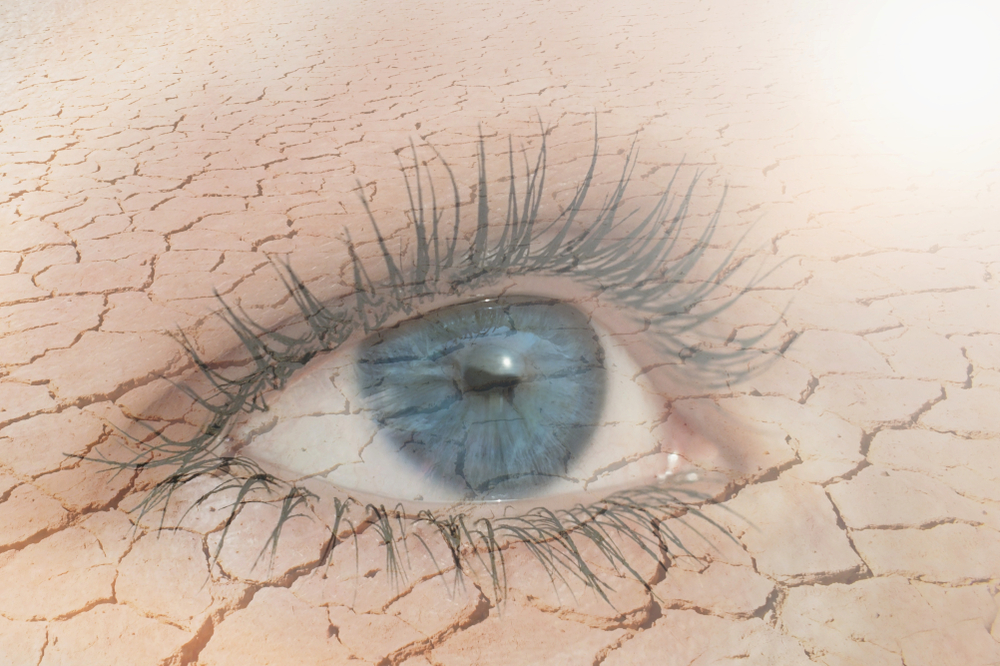
Dry eye is a common eye condition characterized by a deficiency in the tear film, a layer that coats the front surface of the eye, or the cornea. The tear film is very important for lubrication of the cornea, providing comfort of the eyes and clarity of vision. The tear film has three main components: a mucin layer, an aqueous (water) layer, and a lipid (oil) layer. Deficiencies in any one of these layers can lead to dry eye.
There are two main types of dry eye:
- Aqueous deficient dry eye: occurs when the lacrimal glands do not produce enough of the watery (aqueous) component of the tears. This type of dry eye can be caused by systemic disorders, including Sjögren’s syndrome, and certain medications, including antihistamines and decongestants.
- Evaporative dry eye: is caused by the blockage of the meibomian glands, which are the small glands along the upper and lower eyelids responsible for making the oil layer of the tear film. The oil layer is responsible for keeping the tears on the surface of the eye. When there is a deficiency in the oil layer, the natural tears evaporate more quickly from the surface of the eye leading to dryness. Dysfunctional meibomian glands are both a cause and effect of blepharitis, a condition characterized by chronic inflammation of the eyelids.
Common symptoms of dry eye include:
- Persistent dryness or grittiness in the eyes
- Burning or stinging sensations
- Redness and irritation
- Excessive tears (as a reflex response to dryness)
- Blurred vision
- Sensitivity to light
Treatment Options:
Over-the-counter treatments are readily available and can provide relief for mild to moderate cases of dry eye. These treatments include:- Artificial tears: Lubricating eye drops that help moisten the eyes and alleviate dryness. They can be used as needed through the day.
- Lubricating ointments or gel drops: Thick, long-lasting ointments and gel drops that provide extended relief by forming a protective layer of the eyes. Typically used before bedtime.
- Warm Compresses: Application of warm compresses to the eyes can help improve oil gland function by melting thickened oil clogging the gland opening. This allows the oils to be secreted into the tears to stabilize tear composition and improve meibomian gland flow.
- Lid Scrubs: Gentle cleansing of the eyelids using specialized wipes or solutions to remove debris and improve eyelid hygiene to help reduce inflammation.
- Omega-3 fatty acid supplements: help reduce inflammation and promote good oil production.
Prescription Treatments:
- Anti-inflammatory Eye Drops (Xiidra): Medications that reduce inflammation in the tears to help alleviate dry eye symptoms.
- Immunomodulators (Restasis): Prescription eye drops that help suppress the immune response causing inflammation and dryness.
- Serum tears: Eye drops that are made out of a patient’s own blood. Serum is the clear fluid that remains after the red blood cells and proteins are removed from the blood. These drops have healing and nurturing properties beyond that of over-the-counter artificial tears.
- Oral antibiotics: Helps decrease the bacterial load covering the eyelashes and reduces inflammation of the eyelids.
Procedural Treatments:
- In some cases, procedural treatments may be recommended to manage dry eye symptoms effectively. These treatments are typically performed in an eye clinic by a qualified professional and can include:
- Punctal plugs: Small devices inserted into the tear ducts to slow the draining of tears, helping to retain moisture on the eye’s surface.
- Meibomian Gland Expression: Your doctor applies heat to the eyelids and then manually expresses the oil glands that line your eyelids to improve the functionality and flow of those glands to help improve tear composition.
- Intense Pulsed Light (IPL) Therapy: The use of pulses of light energy to target and reduce inflammation of the eyelid glands, improving oil flow and tear quality.
- Amniotic Membrane Grafting: The application of amniotic membrane tissue onto the eye’s surface to promote healing, reduce inflammation, and improve lubrication.
It’s important to consult with an eye care professional to determine the most suitable treatment options based on the severity and underlying causes of your dry eye condition. If you feel you have dry eye, please schedule an appointment with one of our healthcare providers.
Author: Dr. Mallory Troyer












